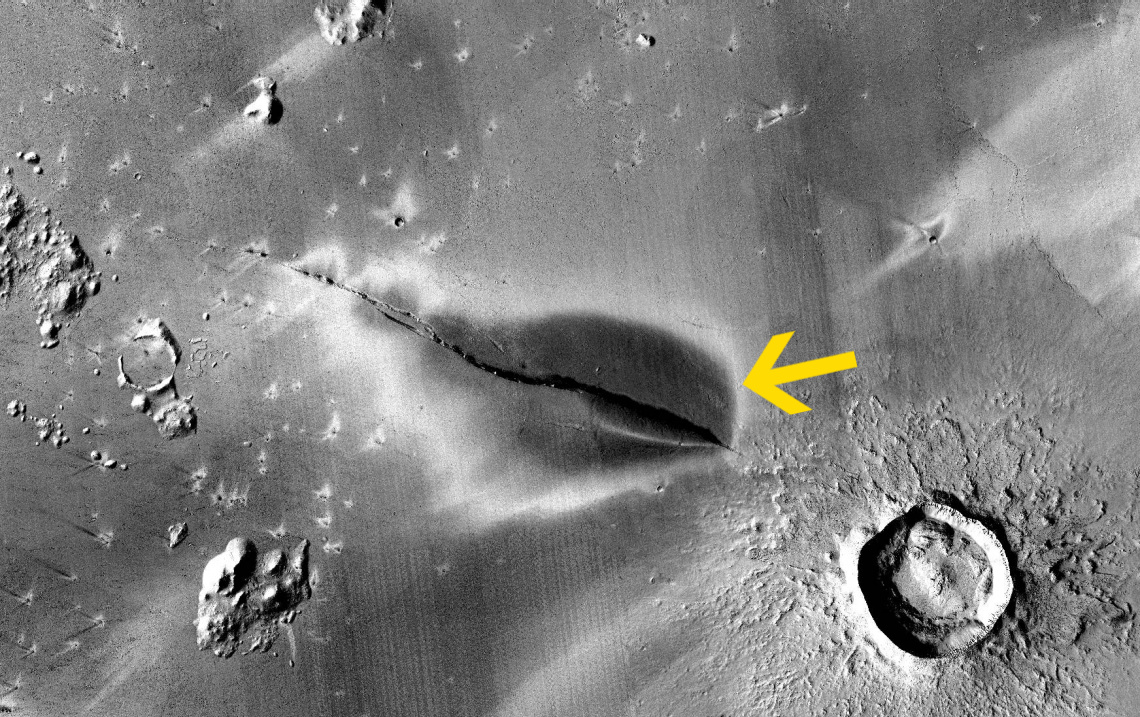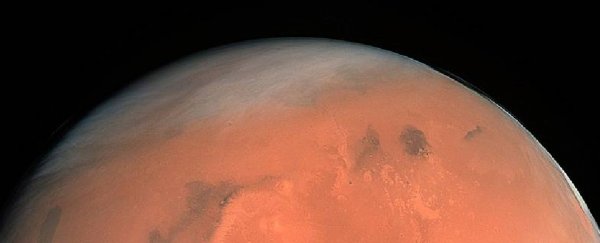Evidence seems to be mounting for a geologically and volcanically active Mars.
A new, close study of volcanic features on the surface of the red planet has found that a lava deposit on the Elysium Planitia appears to be very recent indeed - as in, within the last 50,000 years.
On geological timescales, that's shockingly short. And it could mean that Mars was potentially habitable just as recently, with parts of it similar to regions of volcanic activity in glacial areas such as Iceland, where various forms of extremophile bacteria thrive.
"This may be the youngest volcanic deposit yet documented on Mars. If we were to compress Mars geologic history into a single day, this would have occurred in the very last second," said astronomer David Horvath of the Planetary Science Institute and the University of Arizona.
 Volcanic deposit seen around a fissure in the Cerberus Fossae. (NASA/JPL/MSSS/The Murray Lab)
Volcanic deposit seen around a fissure in the Cerberus Fossae. (NASA/JPL/MSSS/The Murray Lab)
Mars has been full of surprises recently, for such an apparently dry, dusty ball of rock, with several lines of evidence suggesting volcanic activity.
One is the presence of liquid water under the surface. Mars, for all its warm coloring, is a very cold place; a 2019 paper found that internal heating might be necessary to keep subsurface water from freezing. Then last year, another paper described how a Martian meteorite contained evidence of volcanic convection in the Martian mantle.
Now, using satellite data, a team of astronomers led by Horvath has found another clue - a volcanic deposit on the Elysium Planitia, a broad, smooth plain just north of Mars' equator.
"This feature is a mysterious dark deposit, covering an area slightly larger than Washington DC. It has a high thermal inertia, includes high‑calcium pyroxene-rich material, and is distributed symmetrically around a segment of the Cerberus Fossae fissure system in Elysium Planitia, atypical of aeolian, or wind-driven, deposits in the region," Horvath said.
"This feature is similar to dark spots on the Moon and Mercury suggested to be explosive volcanic eruptions."
Most volcanic features on the Martian surface are from surface lava flows, not volcanic explosions, although explosive volcanic features are certainly not unknown. What makes the team's discovery so interesting is that it is on top of other, surrounding lava flows - meaning it occurred more recently.
It also appears to be relatively fresh, containing lava and ash.
"This eruption could have spewed ash as high as 10 kilometers (6.2 miles) into the Martian atmosphere but likely represents a last gasp of erupted material," Horvath explained.
"Elysium Planitia hosts some of the youngest volcanism on Mars, dating around 3 million years ago, so it is not entirely unexpected. It is possible that these sorts of deposits were more common but have been eroded or buried."
Interestingly, other hints of activity have been detected in the same region. The Mars InSight lander is just 1,600 kilometers (1,000 miles) or so from the feature, and has detected earthquake activity in the Cerberus Fossae.
Put together, the two pieces of evidence suggest that activity inside Mars may be ongoing. It's important not to over-interpret the detections, since near-surface lava so late in Mars' life is unlikely without the presence of surface lava flows, and therefore deeper magma is required to explain the eruption.
That's possible, though. Earthquakes can cause eruptions of magma here on Earth, and earthquakes have been detected in the Cerberus Fosse; that suggests one potential mechanism. The feature is also not far from a contemporaneous impact crater, called Zunil. That impact could also have triggered volcanic activity.
However the eruption was triggered, the detection raises the intriguing prospect - albeit still a slim prospect - of relatively recent life on Mars, similar to those found at hydrothermal vents on Earth, where extremely cold conditions meet boiling hot temperatures. Microbial life thrives at these locations, relying not on photosynthesis but chemical reactions for survival.
"The interaction of ascending magma and the icy substrate of this region could have provided favorable conditions for microbial life fairly recently and raises the possibility of extant life in this region," Horvath said.
This could help plan out future Mars missions by providing a location where evidence of life might be found.
The research has been published in Icarus.
